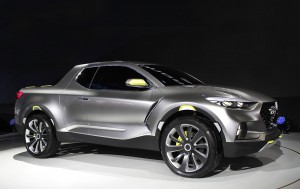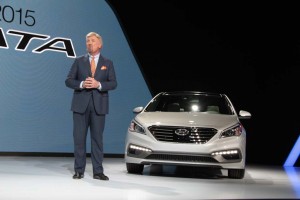
Hyundai won rave reviews for the Santa Cruz concept, a car-based pickup, which it could sorely use in its U.S. line-up right now.
Korean automotive powerhouse Hyundai-Kia has missed its sales target, with global volume dropping 2% in 2016, its first decline in 18 years.
But the world’s fifth-largest automaker is forecasting it will get back on track in 2017, in large part by increasing its production for China and the United States. Industry analysts caution that Hyundai-Kia could be forced to trade sales for profit margins in the New Year, however, especially if those two key markets continue to lose momentum.
“With the global economy continuing its low growth, trade protectionism spreading and competition intensifying in the automobile industry, uncertainty is growing more than ever,” Hyundai Motor Group Chairman Chung Mong-koo told employees in a New Year’s message.
The automaker is expected to report a full-year dip in U.S. sales for 2016, reversing years of strong growth. That led the company to oust its CEO Dave Zuchowski last month. The head of sales in the home South Korean market was also replaced, as was the CEO of Chinese operations.
Worldwide, Hyundai has been taking a number of steps to rein in expenses as demand has declined, ordering pay cuts for senior managers, trimming travel expenses and even cutting maintenance spending on things like light bulbs.
All told, Hyundai and Kia said their global sales dropped to 7.88 million in 2016. The Hyundai side of the company reported demand of 4.86 million, off from the original 5.01 million target. Key fell about 100,000 units short of its sales target of 3.12 million vehicles.

Hyundai let its U.S. Chief Dave Zuchowski, shown at the launch of the 2015 Sonata, amidst several changes the maker is tackling.
(Profits tumbling, Hyundai on cost-cutting binge. Click Here for the story.)
A variety of factors appeared to contribute to that dip, including increased global competition and, in particular, the shift in key markets from traditional passenger cars to SUVs, crossover-utility vehicles and other light trucks. That was especially noticeable in the States, where the Hyundai and Kia brands each market just two utility models, a fraction of the product range offered by key competitors such as Toyota and General Motors.
Ironically, now-ousted Hyundai Motor America CEO Zuchowski was a strong advocate of expanding that brand’s ute mix, and had also been pressing hard for a production version of the popular Santa Cruz concept pickup unveiled several years ago.
The weak sales numbers are expected to translate into a fourth consecutive year of declining profits. Even with an upturn in sales in 2017, the company could be pressed to boost costs for rebates, subsidized leases, low-interest loans and other incentives.
But the target for the New Year is a strong 5% increase, or 5.08 million at Hyundai, and 3.17 million for Kia.
(Trump attacks GM over Mexican-made Chevy Cruze hatchback. Click Here for the story.)
Along with developing new products to fill gaps in the line-up, Hyundai-Kia plans to expand production capacity in both China and the U.S. The Chinese market slowed sharply in 2016, though it rebounded modestly during the latter half of the year.
As for the U.S., the overall new car market is expected to just barely squeak to a third consecutive annual record of around 17.4 million when final figures are announced on Jan. 4. The big question is not whether the market will slow in 2017 but by how much. Estimates from firms like IHS Automotive and J.D. Power run anywhere from 17.2 million to just under 17 million.
But Hyundai’s ambitions for the U.S. could hit another snag in the form of an incoming president who wants to curtail automotive imports from Mexico. A new tweet from President-elect Donald Trump singled out General Motors for bringing in a small number of Mexican-made Chevrolet Cruze Hatchbacks. The businessman-cum-politician repeatedly criticized Ford for its plans to shift small car production south of the border.
He is threatening a 35% tariff or other trade barriers that could make it difficult to bring any new Hyundais, as well, across the border. Ford blunted that strategy a bit today by announcing it would no longer be building a new $1.6 billion plant in San Luis Potosi, Mexico, to build small cars. The company intends to shift production of the Ford Focus, which along with other small and midsize cars are seeing sales slide, to an existing facility in Hermosillo, Mexico.
(Management shake-up as Hyundai ousts top U.S. exec. Click Here for the story.)
The automaker also plans to invest $700 million into its Flat Rock, Michigan, site to produce a new battery-electric SUV with a 300-mile range, as well as hybrids and autonomous vehicles.
